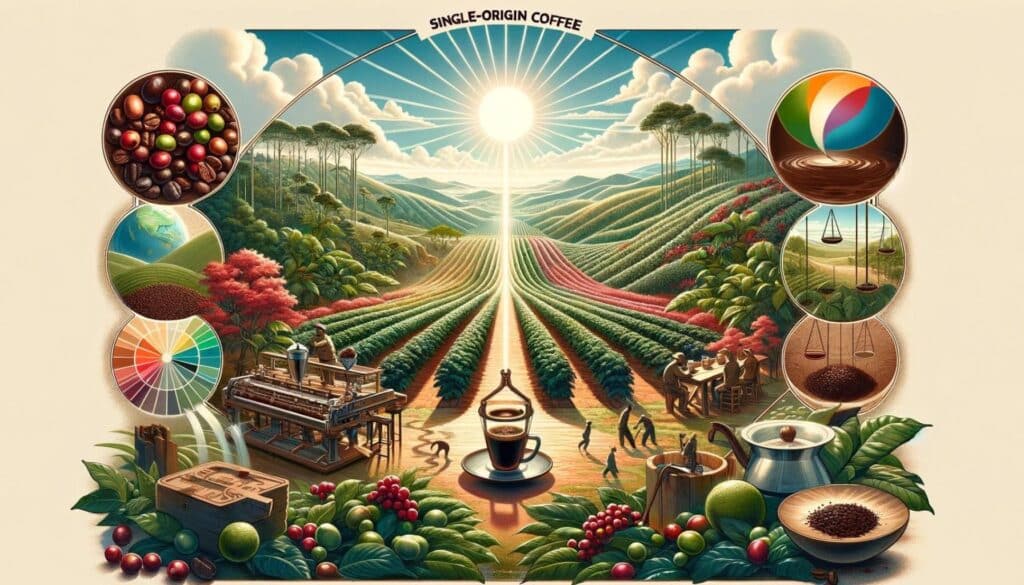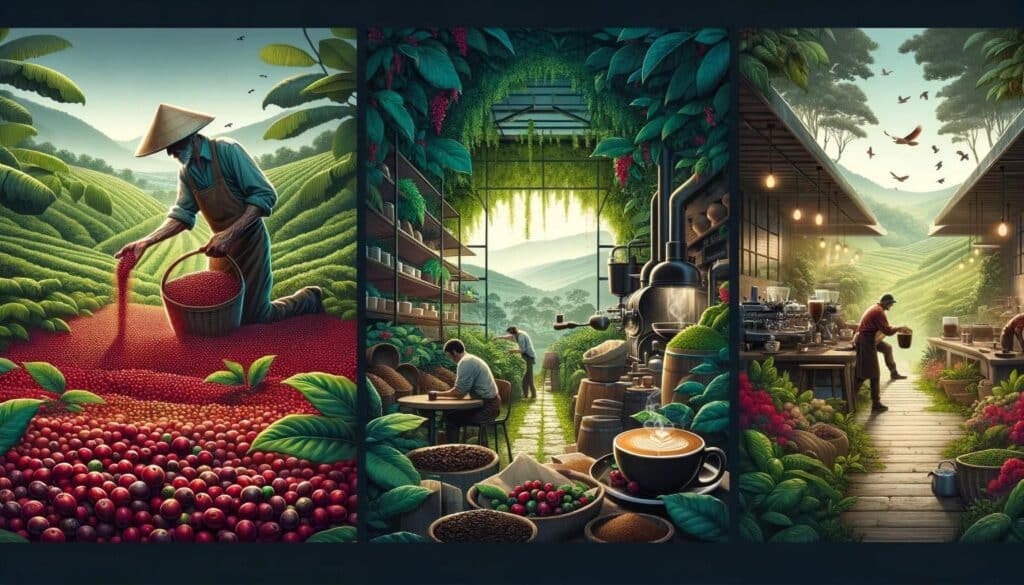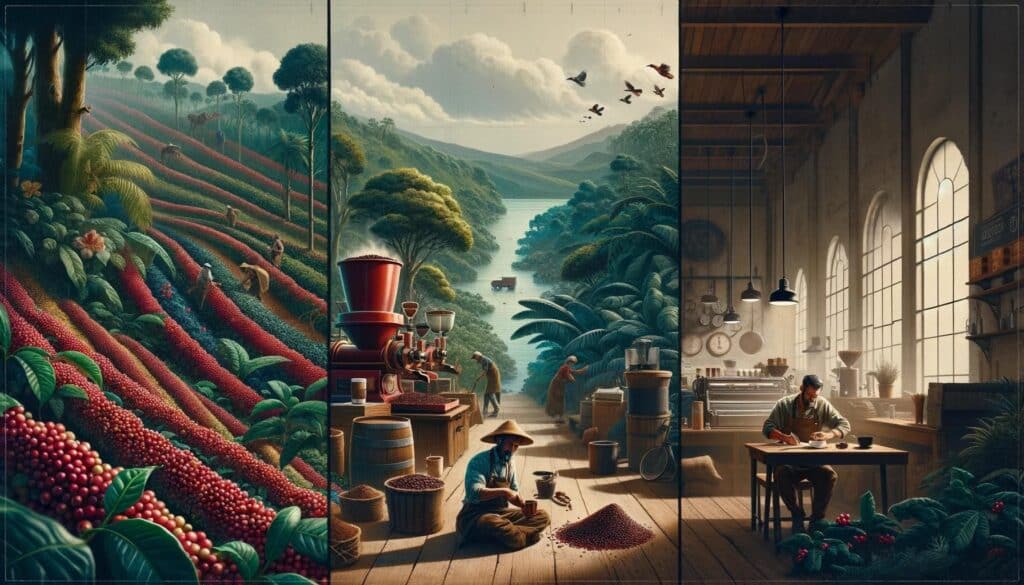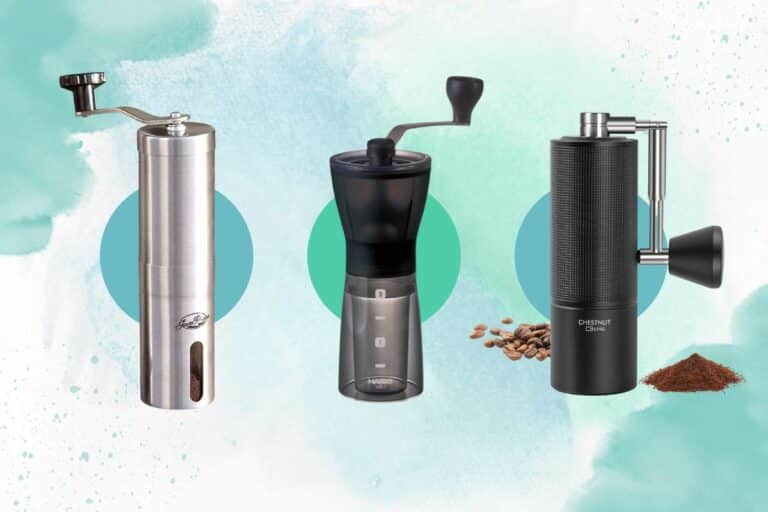Coffee is much more than just a way to start your morning or a quick pick-me-up; it’s a worldwide craze that brings together different cultures, economies, and the environment. In the big coffee world, there’s a term that’s been catching on with both serious coffee lovers and those who just enjoy a cup now and then: single origin coffee. This isn’t just some trendy phrase; it’s part of a movement toward being open about where coffee comes from, focusing on quality, and really valuing the coffee’s journey from the seed all the way to your cup.
What Is a Single Origin Coffee?
Single origin coffee refers to coffee that is sourced from a single location, which can be a single farm, a specific collection of beans from a single country, or even a particular region within a country. This contrasts with blends, which are made from beans sourced from multiple locations, sometimes even multiple countries, to create a specific flavor profile.
At its heart, single origin coffee comes from one specific place. This could be a single farm, a certain area in a country, or sometimes even a whole country itself. Unlike blends, which mix beans from different places to get a consistent taste, single origin coffee lets you taste the unique flavors that come from its very own terroir. Terroir means all the environmental elements like soil, climate, and elevation that affect how the coffee tastes and smells.
The growing interest in single origin coffee matches up with a bigger trend where people care more about quality, knowing where their products come from, and making sure things are sourced in a fair way. People want to know the story of their coffee, who grows it, and what makes it special. This curiosity helps people appreciate their coffee more and supports a coffee industry that’s fairer and more sustainable.
Digging into single origin coffee opens up a world of different tastes and smells, but also the stories of the communities and places that create these coffee experiences. It’s an invitation to explore the world one cup at a time, connecting with far-off lands and the hardworking people who grow these beloved beans. This rising interest in knowing where coffee comes from and wanting it to be good quality is more than just a passing fad; it’s a move toward a more knowledgeable and thoughtful way of enjoying one of the world’s favorite drinks.
Understanding Single Origin Coffee

Definition of Single Origin Coffee
Single origin coffee comes from coffee beans picked from just one place. This can mean beans all from one farm or estate (which people think is the most exact way to describe single origin), beans from a specific area within a country, or beans from several farms in one country but not mixed with beans from anywhere else. The main thing about single origin coffee is that you can trace it back to where it grew, giving you a special look at the environment and how people grow coffee there.
How Single Origin is Different from Blends
To really get why single origin coffee is special, we need to see how it’s different from blended coffee. When people make blended coffee, they mix beans from different places to get a taste that stays the same all the time. They pick beans that mix well together to balance out the taste, how heavy or light the coffee feels, and the different flavors, aiming to make a coffee that lots of people like and that tastes the same year-round, no matter what’s happening with the coffee crops.
Key Differences Between Single Origin and Blends:
- Flavor Complexity and Uniqueness: Single origin coffees are celebrated for their unique flavor profiles, which can vary dramatically depending on their terroir. These coffees can offer a range of flavors, from floral and fruity to nutty and earthy, often with a distinct acidity and body that reflects their origin’s climate, soil, and elevation. Blends, meanwhile, aim for a balanced and harmonious taste that may sacrifice the unique characteristics of individual origins.
- Seasonality: Single origin coffees are typically seasonal, with their availability depending on harvest times and conditions in their specific regions. This seasonality can lead to a rotating selection of single origin coffees throughout the year, each offering a snapshot of its harvest period. Blends, by contrast, are designed to be available year-round, with their consistent flavor profile maintained by adjusting the blend components as needed.
- Traceability and Transparency: One of the hallmarks of single origin coffee is its traceability. Consumers can know exactly where their coffee comes from, down to the farm or region, allowing for a greater understanding and appreciation of the coffee’s background, including the cultivation practices and the efforts of the farmers. Blends, given their mix of origins, do not offer this level of transparency, making it harder to trace the coffee back to its source(s).
The appeal of single origin coffee lies not just in its unique flavors but also in the story it tells about its place of origin. It allows coffee drinkers to embark on a global tasting journey, exploring the diverse landscapes and cultures that contribute to the world of coffee. In contrast, blends offer consistency and a balanced profile, catering to those who prefer a familiar taste experience with every cup. Both single origin coffees and blends have their place in the coffee landscape, each offering a different perspective on the beloved beverage.
The Importance of Terroir in Single Origin Coffee

Explanation of “Terroir” and Its Impact on Coffee Flavor
The idea of “terroir,” which we originally got from the wine world, talks about all the environmental elements like climate, soil, altitude, and farming methods that come together where we grow a crop. For coffee, terroir plays a huge role in shaping everything about the beans—like their taste, smell, body, and how acidic they are. So, every single origin coffee tells the story of where it comes from through its unique flavor that you can’t find anywhere else.
Terroir changes how coffee turns out in many ways. It doesn’t just affect how well the coffee plants grow; it also changes the tiny details in flavor that make one coffee origin stand out from another. For example, the same kind of coffee plant can taste really different depending on where we grow it because of the differences in terroir.
How Climate, Soil, and Altitude Affect Coffee Taste
- Climate: The weather plays a big part in growing coffee. Places with clear wet and dry seasons work really well because they help coffee cherries grow and ripen just right. Take Ethiopian coffees, for example. They grow in an area with just the right amount of rain and warm temperatures, making them taste floral and fruity.
- Soil: What the soil is like, including what minerals are in it and its pH level, can really change a coffee’s taste. Coffee plants grown in volcanic soil, which has lots of minerals and is a bit acidic, tend to produce coffee that tastes brighter and might even feel a bit mineral-like. In places like Antigua, Guatemala, this volcanic soil makes the coffee taste complex, with a bright acidity and chocolatey notes.
- Altitude: Higher up means cooler temperatures, which slow down how coffee cherries mature. This extra time lets the beans develop complex sugars, leading to denser beans that pack more nuanced flavors. Higher altitude coffees, like those from Colombia’s highlands, are famous for their smooth taste and hints of nutty and fruity flavors.
With all these factors playing together, single origin coffees bring a wide array of flavors to the table, from the bright, citrusy tastes of a Kenyan coffee grown high up to the rich, earthy flavors of a Sumatran coffee from volcanic soils at lower elevations. This variety is what draws enthusiasts and connoisseurs to single origin coffee, offering a taste journey that connects drinkers with the far-off lands and cultures where these coffees come from. By understanding and valuing terroir, coffee lovers can dive deeper into their favorite drink, celebrating the unique tastes each origin offers.
Types of Single Origin Coffee

The term “single origin” encompasses a variety of categories, each defined by the specificity of where the coffee is grown. These categories allow coffee enthusiasts to explore the diversity of flavors offered by different landscapes around the world. Here’s a breakdown of the main types of single origin coffee:
Single Farm or Estate
- Definition: Coffee sourced from a single farm, estate, or plantation. This category offers the highest level of traceability and specificity, as all the beans come from the same property.
- Impact on Flavor: The microclimate, soil composition, and cultivation practices of a single farm can impart unique flavor nuances to the coffee. This can include specific varietals of coffee plants favored by the farm, innovative processing methods, or sustainable farming practices that enhance the coffee’s taste profile.
- Example: A coffee estate in Panama known for producing the highly sought-after Geisha varietal, which is celebrated for its floral aromatics and complex flavor notes.
Single Region or Area
- Definition: These coffees are sourced from a broader geographical area within a single region or part of a country. The region is known for its distinctive coffee flavor profile, influenced by the general climate and soil conditions of the area.
- Impact on Flavor: While offering less specificity than single farm coffees, single region coffees still provide a distinct taste characteristic of their broader area. This includes regional variances in flavor, such as the citrus and berry notes found in coffees from the Sidamo region of Ethiopia, where the combination of elevation, climate, and soil creates an ideal environment for these flavor profiles.
- Example: Coffee from the Sidamo region of Ethiopia, known for its light, fruity flavors with floral hints, reflecting the high altitudes and rich soils of the area.
Micro-Lot
- Definition: Micro-lot coffees are a subset of single farm coffees, representing an even more selective category. These coffees are sourced from a specific plot within a farm, often isolated due to its exceptional soil quality or microclimate, or from a particular harvest that produced an outstanding batch of coffee.
- Impact on Flavor: Micro-lots are often associated with premium quality and unique, exceptional flavors. They allow farmers to highlight the best of their production, often featuring rare varietals or innovative processing methods that result in distinct, sought-after flavor profiles.
- Example: A micro-lot from a renowned Colombian farm, which might produce a limited batch of coffee with unique tasting notes, such as jasmine and honey, due to the specific conditions of the plot and meticulous processing.
Each type of single origin coffee offers a different level of specificity and insight into the terroir’s impact on coffee flavor. From the broad regional characteristics to the nuanced differences of a micro-lot, these categories invite coffee lovers to deepen their understanding and appreciation of coffee, exploring the rich tapestry of flavors and stories behind each cup.
Advantages of Single Origin Coffee

Single origin coffee offers a range of benefits that extend beyond the cup, impacting everything from the palate to the global coffee community. Here are some of the key advantages:
Flavor Uniqueness and Complexity
- Distinctive Profiles: Each single origin coffee brings a unique flavor profile that reflects its terroir. This uniqueness allows coffee drinkers to explore a wide array of tastes, from bright and fruity to rich and earthy, depending on the origin’s specific environmental conditions.
- Complexity and Nuance: The specific conditions of soil, altitude, and climate in a single origin can lead to a more complex and nuanced flavor profile compared to blends. This complexity is a result of the coffee beans developing under a consistent set of conditions, allowing for a more pronounced expression of flavor characteristics.
Transparency in Sourcing
- Traceability: Single origin coffee often comes with a high level of traceability, allowing consumers to know exactly where their coffee comes from. This transparency can cover the specific farm, the processing methods used, and even the varietal of coffee plant, offering a clear connection between the consumer and the origin of their coffee.
- Ethical Sourcing: The demand for single origin coffee supports more transparent sourcing practices, which can lead to better ethical standards in the coffee industry. This includes fair compensation for farmers and a focus on sustainable farming practices, as consumers are often willing to pay a premium for coffee that is responsibly sourced.
Support for Local Farmers and Communities
- Economic Benefits: Single origin coffee can command higher prices in the market due to its unique characteristics and the premium placed on traceability and ethical sourcing. This financial incentive can significantly benefit local farmers, providing them with a better income and encouraging the production of high-quality coffee.
- Community Development: The focus on single origin coffee can lead to investment in local communities, including improvements in infrastructure, education, and health services. As the demand for high-quality, responsibly sourced coffee grows, so does the opportunity for positive impacts on the communities involved in its production.
- Preservation of Local Varietals and Techniques: The interest in unique flavors and profiles encourages the preservation of indigenous coffee varietals and traditional farming and processing techniques. This not only contributes to the diversity of coffee available but also helps maintain agricultural biodiversity.
Single origin coffee offers a pathway to a more ethical, transparent, and diverse coffee industry. By prioritizing the unique flavors and stories of individual origins, consumers and producers alike are part of a movement that values quality, sustainability, and community. The advantages of single origin coffee extend far beyond the cup, supporting a model of coffee production and consumption that benefits everyone along the supply chain, from the local farmers to the end consumers.
Challenges with Single Origin Coffee

While single origin coffee offers numerous advantages, it also presents certain challenges that both consumers and producers face. These challenges stem from the inherent nature of focusing on coffee from a single source and the dynamics of the global coffee market.
Seasonality and Availability
- Limited Harvest Periods: Single origin coffees are subject to the agricultural cycles of their specific regions, meaning they’re often available only during certain times of the year. This seasonality can limit the availability of specific origins, making it challenging for both consumers who wish to enjoy their favorite coffees year-round and for roasters who seek to maintain a consistent lineup.
- Impact of Climate Change: The effects of climate change, including unpredictable weather patterns and increased incidence of pests and diseases, can significantly impact the availability and quality of single origin coffees. Regions that depend heavily on specific environmental conditions for their unique flavor profiles may face challenges in maintaining consistent quality and supply.
Higher Price Points
- Cost of Production and Sourcing: The meticulous attention to cultivation, harvesting, and processing required to produce high-quality single origin coffee often results in higher production costs. Additionally, the logistics of sourcing coffee from specific, sometimes remote, locations can add to the overall cost.
- Premium for Quality and Traceability: The premium placed on the unique qualities and traceability of single origin coffees often translates to higher prices for consumers. While many enthusiasts are willing to pay extra for these attributes, the price point can be a barrier for some, limiting the accessibility of single origin coffees to a broader audience.
Variability in Quality
- Inherent Risks of Single Source: Relying on a single geographic location for coffee can result in variability in quality from year to year, as factors such as weather, pests, and other environmental conditions can affect the crop. This variability can be challenging for roasters and retailers who strive to offer a consistent product to their customers.
- Challenges in Consistency for Producers: For coffee producers, achieving a consistent level of quality across harvests can be challenging, especially given the impact of changing environmental conditions. This inconsistency can affect their ability to command premium prices and maintain relationships with buyers who expect a certain standard of coffee.
Despite these challenges, the interest in and demand for single origin coffee continue to grow, driven by a collective desire among consumers, roasters, and producers to explore and celebrate the diversity of coffee. Addressing these challenges requires innovative solutions and collaborative efforts across the coffee industry to ensure that single origin coffee can be enjoyed sustainably and responsibly by future generations.
How to Choose and Enjoy Single Origin Coffee

Selecting and enjoying single origin coffee can be a delightful journey into the world of coffee flavors and aromas. Here are some tips on how to choose single origin coffees and the best ways to enjoy them to their fullest.
Tips for Selecting Single Origin Coffee
- Understanding Labels: Single origin coffee labels often contain valuable information about the coffee, including the country of origin, region, farm or estate, altitude, processing method, and sometimes the coffee varietal. Familiarize yourself with these terms to better understand what to expect from the coffee’s flavor profile.
- Roast Dates: Look for the roast date on the packaging. Freshness is crucial in coffee, and beans are best used within a month of their roast date. This ensures you’re getting the coffee at its peak flavor.
- Research Roasters: Different roasters have varying approaches to roasting single origin coffees. Research roasters to find one that aligns with your taste preferences. Some may focus on light roasts that highlight the coffee’s natural acidity and fruitiness, while others may offer a darker roast that emphasizes body and sweetness.
- Experiment: Don’t hesitate to experiment with different origins and processing methods. Each coffee will have its unique taste profile, and exploring them is part of the fun.
Brewing Methods that Enhance Single Origin Coffee Characteristics
- Pour-Over: This method allows for precise control over the brewing time and temperature, making it ideal for highlighting the unique characteristics of single origin coffees. The gentle extraction can showcase the coffee’s complexity and nuanced flavors.
- Aeropress: The Aeropress can produce a rich, full-bodied cup with a clear taste profile, which is excellent for enjoying the distinct flavors of single origin beans.
- French Press: Ideal for coffees with a heavier body and richer texture. The French Press’s full immersion brewing method extracts deep flavors, making it suitable for single origins with chocolatey or nutty profiles.
- Adjust Grind Size and Water Temperature: Fine-tune the grind size and water temperature based on the coffee’s origin and desired flavor extraction. Lighter roasts may benefit from slightly hotter water and a finer grind, whereas darker roasts might do better with cooler water and a coarser grind.
Pairing Food with Single Origin Coffee
- Complementary Flavors: Pair coffee with foods that complement its dominant flavor notes. For instance, a coffee with berry notes might pair well with a blueberry muffin, while a coffee with nutty characteristics could complement almond croissants or chocolate.
- Contrast Pairing: Alternatively, choose foods that contrast with the coffee’s flavors to highlight its profile. A bright, acidic coffee could be paired with something sweet and creamy, balancing the coffee’s acidity.
- Consider the Time of Day: Morning coffees might be paired with lighter fare like pastries or fruit, while afternoon or evening coffees could accompany richer desserts or savory snacks.
Exploring single origin coffee is about more than just tasting; it’s about experiencing the diverse world of coffee cultivation and production. By selecting carefully, brewing thoughtfully, and pairing intelligently, you can deepen your appreciation for the unique qualities that single origin coffees have to offer.
The Role of Single Origin Coffee in the Specialty Coffee Movement

Single origin coffee has played a pivotal role in shaping the specialty coffee movement, contributing significantly to its growth and the evolving relationship between consumers and producers. Its influence extends beyond mere consumption, affecting the industry’s standards, ethics, and sustainability practices.
Contribution to the Growth of the Specialty Coffee Industry
- Elevating Coffee Quality: Single origin coffee has been at the forefront of the industry’s push for higher quality standards. Its emphasis on the distinct flavors and profiles specific to particular regions or farms has encouraged both producers and roasters to focus on quality over quantity. This pursuit of excellence has led to innovations in farming, processing, and roasting techniques, all aimed at enhancing the unique characteristics of single origin beans.
- Market Differentiation: The specialty coffee movement thrives on differentiation, and single origin coffees offer exactly that. By highlighting the unique attributes of coffees from specific regions or farms, the industry can cater to a more discerning consumer base looking for a premium, differentiated product. This has opened up new markets and created niches within the coffee industry that were previously untapped.
- Education and Awareness: Single origin coffee has also played a crucial role in educating consumers about coffee as a product of agriculture, not just a commodity. Through single origin coffees, consumers learn about the impact of terroir, the importance of sustainable farming practices, and the realities of coffee production. This educational aspect has fostered a more informed and conscientious consumer base, which in turn supports the growth of the specialty coffee industry.
How Single Origin Coffee Fosters a Deeper Connection Between Consumers and Producers
- Transparency and Traceability: One of the hallmarks of single origin coffee is its traceability. Consumers can know the exact origin of their coffee, down to the farm or cooperative. This level of transparency builds trust and fosters a deeper connection between consumers and producers, as buyers can appreciate the effort and care that goes into each cup.
- Supporting Sustainable Practices: The demand for single origin coffee often comes with a willingness to pay a premium for ethically sourced, sustainably produced coffee. This financial incentive encourages producers to adopt sustainable practices, not only in terms of environmental impact but also in fair labor practices. Consumers, in turn, feel a sense of participation in supporting these practices, creating a virtuous cycle that benefits all stakeholders.
- Sharing Stories: Single origin coffee carries with it the stories of the people and places behind the product. Roasters and cafes often share these stories, highlighting the farmers’ efforts, the challenges they face, and the communities they belong to. This storytelling aspect adds an emotional dimension to the coffee, allowing consumers to feel a part of something larger than just the act of drinking coffee.
The role of single origin coffee in the specialty coffee movement is multifaceted, driving not just industry growth but also a more ethical, sustainable, and connected coffee culture. It highlights the coffee industry’s potential to create positive change, from the local level of individual farms to the global community of coffee consumers. Through single origin coffee, the specialty coffee movement continues to evolve, marked by a shared commitment to quality, transparency, and sustainability.
Conclusion
Single origin coffee really shows off the diversity and richness of the coffee world, giving us a special kind of value and experience that’s about more than just drinking coffee. It captures the spirit of where it comes from, sharing stories of the land, the weather, and the people who grow and pick the coffee beans. Every cup gives us a taste of the different flavors, smells, and qualities that come from the unique terroir, making each tasting experience one of a kind, different from region to region and farm to farm.
Diving into single origin coffee isn’t just about enjoying these distinct features; it’s also about gaining a deeper understanding and appreciation for coffee in general. It calls on coffee lovers and casual drinkers alike to dig into the complexities and fine points of coffee, promoting a more thoughtful and responsible way of drinking it. Single origin coffee connects consumers to a story that champions sustainability, ethical sourcing, and the well-being of coffee farmers across the world.
Looking into coffee’s future, single origin coffees lead the charge in the specialty coffee movement, stretching the limits of quality, openness, and fair practices. This movement goes beyond just sipping a great cup of coffee; it’s about being part of a worldwide community that cherishes the craft and knowledge of making coffee, from the seed all the way to your cup.
So, whether you’re a deep-dive coffee expert or just starting to explore the coffee universe, stepping into the realm of single origin coffees enriches your experience, expanding your taste and deepening your love for this favorite drink. Let every cup invite you to explore, learn, and connect with the wide and exciting world of coffee. Seize the chance to uncover new tastes, stories, and the big impact your coffee choices can make around the globe.
Frequently Asked Questions About Single Origin Coffee
1. How does single origin coffee contribute to biodiversity?
Single origin coffee can play a significant role in promoting biodiversity. By valuing the unique characteristics of coffee from specific regions, there’s an incentive for farmers to preserve native coffee varietals and maintain diverse ecosystems. This contrasts with large-scale monoculture practices that can diminish biodiversity. Moreover, many single origin coffees are grown in shade-covered environments that support a wide range of flora and fauna, contributing to the health of local ecosystems.
2. Can the same coffee plant produce different single origin coffees?
Yes, the same coffee plant can produce coffees that are considered single origin but differ significantly in taste and characteristics, depending on various factors such as the microclimate of where it’s grown, the soil composition, and even the processing method used after harvesting. For instance, a coffee plant grown at a higher elevation on one side of a mountain may yield a different flavor profile than the same varietal grown at a lower elevation on the other side.
3. Why are some single origin coffees much more expensive than others?
The price of single origin coffees can vary widely due to factors like rarity, production costs, and demand. Some varietals are scarce or grow only in specific conditions, making them more expensive. Additionally, the cost of sustainable farming practices, labor-intensive processing methods, and the logistics of exporting from remote regions can also contribute to higher prices. High demand for certain prestigious coffees, such as those that win competitions or are known for exceptional quality, further drives up prices.
4. How does the choice of single origin coffee affect local communities in the coffee-producing regions?
Choosing single origin coffee can have a positive impact on local communities in coffee-producing regions. These coffees often command a higher price in the market, providing farmers with better income. This financial support can lead to community development projects, improvements in education, healthcare, and infrastructure. Furthermore, the focus on quality and sustainable practices helps ensure the long-term health of the land and the economic stability of the community.
5. Is it possible to use single origin coffee for espresso, and how does it differ from using blends?
Absolutely! Single origin coffee can be used to make espresso, offering a unique opportunity to experience its distinct flavors in a concentrated form. The main difference from using blends is that single origin espressos may exhibit a more pronounced taste profile, highlighting specific characteristics of the bean‘s origin, such as acidity, fruitiness, or floral notes. However, creating a balanced single origin espresso requires careful selection and expertise in roasting to ensure the flavors are well-expressed and enjoyable in the espresso form.






